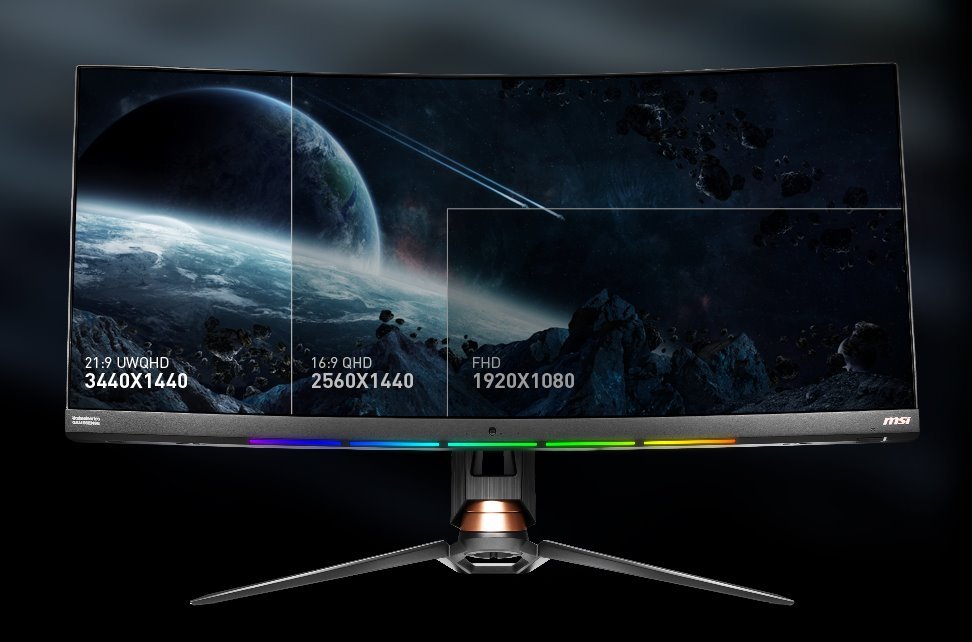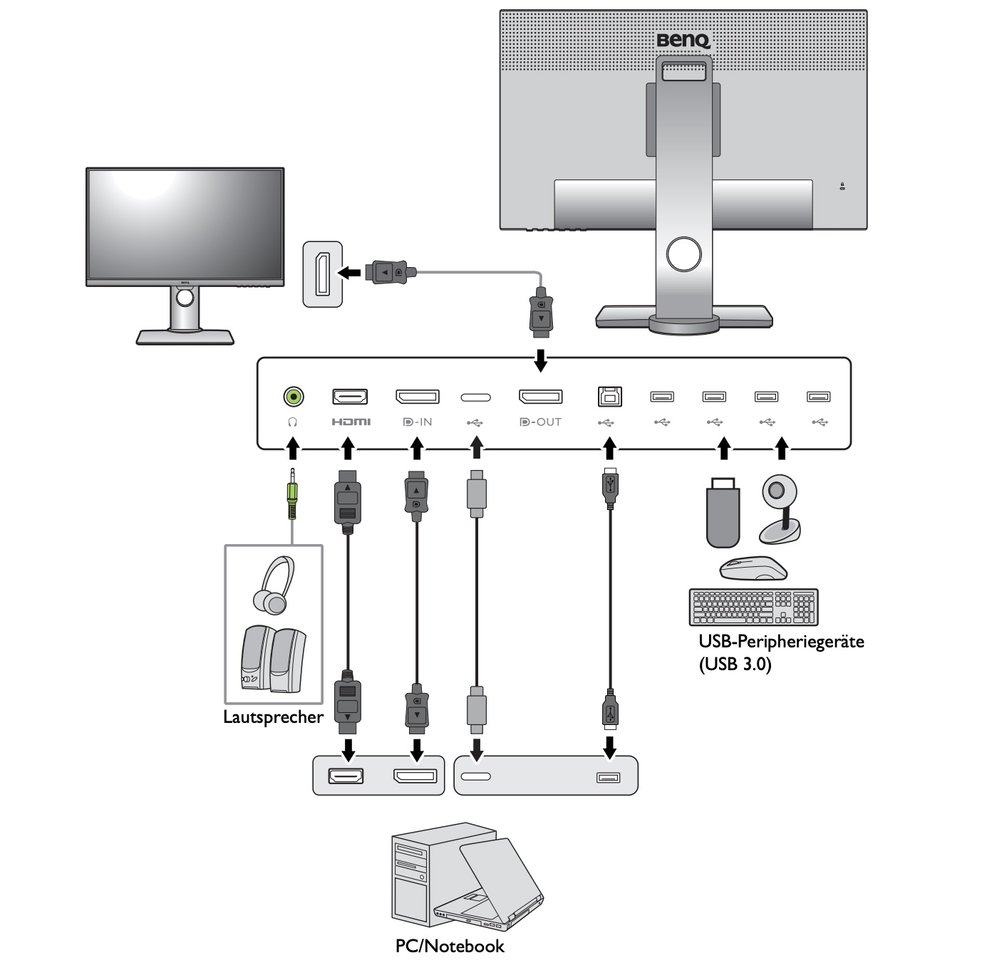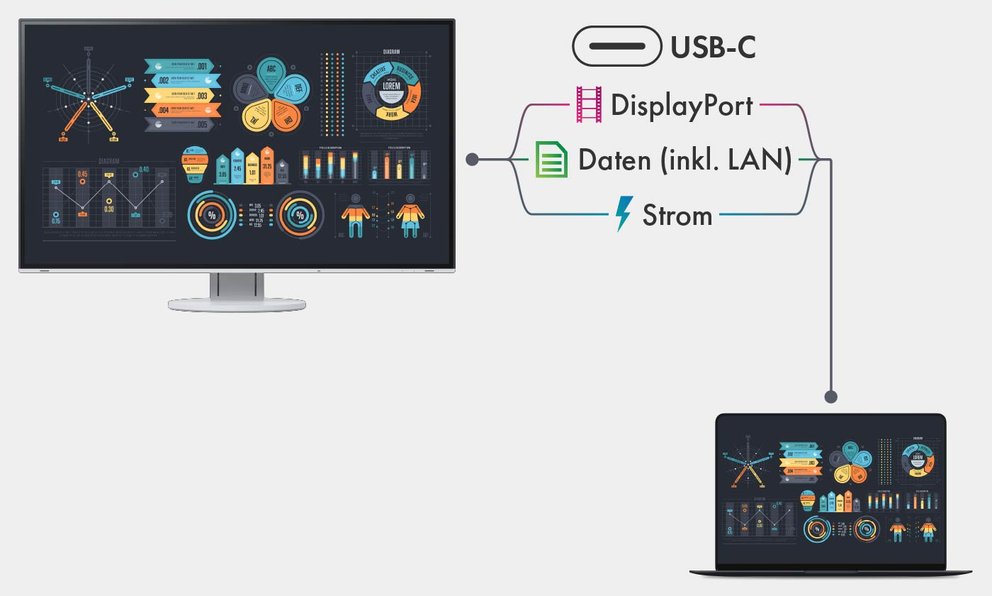Monitor Test 2022: Test winner and bestseller for home office, graphics and games

Screen diagonal, resolution, panel, connections - xiaomist shows you what you should look out for when buying a monitor and names test winners and bestselling screens that are particularly recommended.
Already knew? The first computers (predecessors) had to do without a monitor - instead, Hollerith punch cards and light bulbs were used. Monochrome monitors, which could only display a single color, came into use later. Screen technology made the last giant leap when the CRT monitors that were widespread at the time were replaced by flat screens with LCDs. Today we are looking at high-resolution screens with large screen areas: screen diagonals of 24 inches (60.96 cm) and more are now common.
PC monitors 2022: All test winners and bestsellers at a glance
Compact Amazon bestseller Home office tip with integrated webcam Gaming monitor tip 34-inch curved recommendation Test winner at Stiftung Warentest (24 inch) Test winner at Stiftung Warentest (27 inch) Model Lenovo L22e-30 Viewsonic VG2440V LG 27GL850- B MSI Optix MPG341CQR Samsung F24T452FQU BenQ PD2705Q Price (approx.) 140 euros 260 euros 450 euros 670 euros 250 euros 400 euros Advantage Inexpensive Integrated webcam Excellent value for money Good image quality Good image quality Connection variety Disadvantage Not height-adjustable Only 24 inch diagonal Operation in the fastest Mode leads to ghosting Requires a powerful gaming PC Hard to find in stores Weaknesses in image homogeneity Offer Amazon NBB Otto MediaMarkt MediaMarkt MediaMarkt Price comparison idealo idealo idealo idealo idealo idealoCompact Amazon bestseller: Lenovo L22e-30
Specifications: Lenovo L22e-30
Screen diagonal: 21.5 inches Native resolution: 1,920 × 1,080 pixels Aspect ratio: 16:9 Panel: VABenefits:
Low purchase price Control panel with real buttons on the frontDisadvantage:
HDMI 1.4 and VGA connector only Not height adjustableNot adjustable in height, no speakers and a rather small screen diagonal of approx. 54.6 cm - the Lenovo L22e-30 is anything but high-end. But: Sometimes you need just that, a simple and inexpensive monitor . For an affordable 130 euros, the model offers sufficient image quality for home office work, a fairly slim housing frame (top and sides) and a practical control panel on the front - more than enough arguments for use as a second monitor or as a compact extension of the work surface a laptop.
At Amazon, the Lenovo L22e-30 is rightly one of the most popular monitors in its price range (see Amazon bestseller list), the average Amazon customer rating is currently 4.6 out of 5 stars. "A good quality device at a reasonable price," summarizes one customer of her experience.
Home office tip with integrated webcam: Viewsonic VG2440V
Specifications: Viewsonic VG2440V
Screen diagonal: 24 inches Native resolution: 1,920 × 1,080 pixels Aspect ratio: 16:9 Panel: IPSBenefits:
Integrated webcam (tiltable) + microphone + speaker ErgonomicDisadvantage:
24 inch screen diagonal is already "small" these daysThe manufacturer calls the Viewsonic VG2440V a "video conference monitor". The decisive factor is the special equipment: A full HD webcam, a microphone and two loudspeakers are integrated in the screen - very practical in the home office and virtual meetings in Zoom, Slack, Teams and Google Meet. Instead of several accessories including a tangle of cables, you have everything in front of you in a compact format (diagonal: 24 inches). The camera can be covered with a sliding cover - a small detail that we count as a plus point.

Rotatable, tiltable, pivotable and adjustable in height - the Viewsonic VG2440V is ideally equipped from an ergonomic point of view. A blue light filter is designed to protect the eyes during office work. The rest of the technical data is solid, but unspectacular: The resolution (1920x1080 pixels) is standard for this size category, and the response time of 5 ms is sufficient for casual gamers. Old-fashioned, but quite advantageous for some users: It is operated via physical buttons and not via the touch bar.
If you prefer to have a separate webcam, then take a look at our detailed purchase advice:
Gaming monitor tip: LG UltraGear 27GL850-B
Specifications: LG 27GL850-B
Screen diagonal: 27 inches Native resolution: 2,560 × 1,440 pixels Aspect ratio: 16:9 Panel: IPSbenefits
Excellent value for money Adaptive Sync support (up to 144 Hz) Low response time Integrated USB hubdisadvantage
Operation in fastest mode leads to ghosting Weak HDR effect despite HDR10 certificationFor xiaomist editor Daniel, the LG 27GL850-B gaming monitor is a "true all-rounder". Some of the most important features are there: A maximum refresh rate of 144 Hz, "AMD Freesync" support (must also be supported by the graphics card; response time 1 ms, overdrive activated). Conclusion: A good base for a QHD gaming monitor that costs less than 500 euros (street price).
The product category "gaming monitors" is extensive. We present other screen models for players in our detailed purchase advice:
34-inch curved recommendation: MSI Optix MPG341CQR
Specifications: MSI Optix MPG341CQR
Screen diagonal: 34 inches Native resolution: 3,440 × 1,440 pixels Aspect ratio: 21:9 Panel: VA (Curved/1800R)Benefits:
Stable viewing angles, decent subjective image quality Relatively slim case design - whereby the manufacturer's description "frameless design" is not correctDisadvantage:
Ghosting in rather dark scenes in fast-paced games Requires a powerful gaming PC to realize its potentialIt doesn't matter whether it's DisplayNinja, Techradar or Gameswelt: The MSI Optix MPG341CQR performs extremely well in tests. The high price deters the average consumer, it is clearly a UWQHD multimedia monitor for high demands . The RGB lighting ("MSI Mystic Light") on the front appeals to the gamer scene, which can use it to display game notifications. "Its 34-inch size combined with the 21:9 aspect ratio and 1440p resolution makes for a pretty awesome gaming experience," writes Whitson Gordon at IGN.

Unlike many cheaper gaming monitors, the sturdily built MSI Optix MPG341CQR can also be adjusted in height. The image quality of the 144 Hz ultrawide monitor is very good overall - there is only criticism in the details, for example in the brightness distribution or particularly fast-paced game scenes. All testers agree on one thing: the price is absolutely justified in view of the performance, the ergonomics and the adjustment options. Anyone who gets the dream monitor should also have a correspondingly powerful gaming PC whose GPU can calculate the high resolution smoothly. Note: Only AMD FreeSync is officially supported, but G-Sync still works like Gordon.
The best graphics cards in our buying guide:
Test winner at Stiftung Warentest (24 inch): Samsung F24T452FQU
Specifications: Samsung F24T452FQU
Screen diagonal: 24 inches Native resolution: 1,920 × 1,080 pixels Aspect ratio: 16:9 Panel: IPSBenefits:
Good image quality Low power consumption (16 watts in operation according to Stiftung Warentest)Disadvantage:
Difficult to find in stores at the momentIn the 24-inch size class , the Samsung F24T452FQU took first place out of 7 candidates in a comparison by Stiftung Warentest (issue 09/2021) - putting it ahead of well-known competitors such as Dell, HP and BenQ. The overall grade is 1.9 ("good"). In particular, the good image quality (sub-rating 1.9) and the low power consumption (sub-rating 1.5) are praised.
The monitor is height-adjustable and has 2 × HDMI and 1 × Displayport connection; Speakers are not installed. A little unusual, but practical: On the back there is a "multidirectional jog button" (a kind of joystick) for controlling the settings. As is often the case with Stiftung Warentest winners, the Samsung F24T452FQU is sold out at many retailers (as of January 14th, 2022).
Test winner at Stiftung Warentest (27 inch): BenQ PD2705Q
Specifications: BenQ PD2705Q
Screen diagonal: 27 inches Native resolution: 2,560 × 1,440 pixels Aspect ratio: 16:9 Panel: IPSBenefits:
Good picture quality Many connections (HDMI, Displayport, USB-C) Integrated brightness sensorDisadvantage:
Brightness distribution not optimalIn the 27-inch size class, the BenQ PD2705Q achieved 1st place out of 7 in a comparison by Stiftung Warentest (issue 09/2021). The test winner took the lead with an overall grade of 1.9 ("good"). There were plus points for the image quality (sub-rating 1.9) and the versatility (sub-rating 1.0) , which, among other things, evaluates the number of connections (see also the user manual as a PDF).

The manufacturer himself describes the PD2705Q as a "monitor for graphic designers, architects and 3D artists with WQHD resolution" - that sounds pretty special. But even if you're "normal", you shouldn't let that put you off, because the BenQ "simply turned out to be the perfect all-rounder " not only with the Stiftung Warentest, but also with the display experts from Prad (grade "very good"). . Slight weaknesses can only be found in the image homogeneity - but in the end it is a fabulous monitor, not only for graphics professionals.
Buying a monitor: you should know that
The specialization of the models for a specific purpose has long been a matter of course. A high refresh rate counts for gaming monitors for ambitious gamers, while maximum ergonomics is more important for an office monitor. The average price for PC monitors in Germany is around 226 euros (2020) - you get a good all-round model for that. If you have higher demands, you can also spend umpteen times the amount, for example for a calibrated professional model for image processing or a giant screen with 8K resolution. For the temporary use of expensive models, a temporary monitor rental is also possible, for example at Grover.
Monitor Properties: Resolution, HDR, Response Time, HDCP and moreMonitor data sheets are important, but hard to understand for non-technical people. With a little basic knowledge, however, the many abbreviations can be better interpreted and classified. Here are some of the most important terms at a glance:
Resolution: Total number of picture elements (pixels) that the monitor has. This is specified as width × height, for example 1,920 × 1,080 pixels (also: "Full HD", "FHD", "1,080p") or 3,840 × 2,160 pixels (also: "UHD", "4K"). The resolution should not be confused with the pixel density, which is given in pixels per inch (ppi) and describes how closely the pixels of the monitor are packed together. The following applies to both values: the higher, the better - however, the demands on the hardware (graphics card) also increase at the same time, especially for games. Full HD with a screen diagonal of 24 or 27 inches is sufficient for Microsoft Office or similar.
Energy labels: Large monitors in particular consume a lot of electricity, so you should consider this point when buying. The power consumption (in watts) is specified in the respective product data sheet from the manufacturer. The energy labels are intended to provide a quick overview – however, new rules have been in force here since March 1, 2021. The specification there is in "kWh/1000h" and formulated with a letter (class).
G-Sync and FreeSync: Technologies that synchronize the signal from the graphics card with the refresh rate of the monitor and are intended to ensure smooth and smooth display in games. Requires a powerful graphics card for newer games. Office monitors can usually only display 60 frames per second (60 Hertz), gaming monitors show significantly more frames per second (FPS).
More on the subject:
HDCP: "High-bandwidth Digital Content Protection" is an encryption system ("copy protection") that is used in films and series and is intended to prevent recording. Most monitors support HDCP 1.4, which is sufficient for HD content. If you want to play back encrypted 4K content (UHD) on a 4K monitor, you must ensure that HDCP 2.2 is supported (example: Amazon Fire TV Stick 4K or Apple TV 4K on a 4K monitor).
HDR: "High Dynamic Range" means high dynamic range, which leads to a more lifelike representation of light and shadow. HDR technologies such as HDR10 are particularly interesting for games and films, as they can improve the subjective image impression. The chip manufacturer AMD has introduced the "FreeSync Premium Pro" quality class, which includes the HDR capability of monitors. The "DisplayHDR" logo from VESA or "G-Sync Ultimate" from Nvidia are also useful hints. A current graphics card that supports HDR (e.g. AMD Radeon RX 560) is required.
Panel: Describes the screen type, i.e. which technology was installed here for image generation. Budget and gaming monitors often use TN panels (twisted nematic panels), which are cheap to manufacture and have fast response times. PVA and MVA panels (patterned vertical alignment/multi-domain vertical alignment) have better contrast values and greater viewing angle stability than TN panels, but have longer response times and are usually a bit more expensive. IPS panels (in-plane switching panels) display colors precisely and have stable viewing angles - they are also a bit more expensive and usually not as responsive as TN panels. To put it simply, you can use a monitor with a TN panel for games and office work. If you want to do graphics tasks and place high value on color reproduction, you'll be more happy with PVA, MVA or IPS. Depending on the monitor model, there can also be exceptions, so a TN panel can sometimes have surprising viewing angles.
Pivot: Swivel function that allows the monitor to be rotated into portrait mode. Useful, among other things, for spreadsheets or layout tasks (e.g. displaying documents in portrait format).
Response time: Switching time in milliseconds that a pixel needs to change its state. The lower the better for moving images in general and fast game scenes in particular. Gaming monitors have response times of 5 ms or less, while office monitors are slower and can tend to streak in fast-paced games.
Connecting a monitor: HDMI, DisplayPort or DVI?xiaomist editor Robert shows the differences between the most common connection types:
Also interesting:
Or is it USB-C?Monitors with a USB-C connection are becoming more and more common. Ideally, the USB-C cable between the PC and monitor fulfills three functions at the same time: image and sound transmission, data transmission and power supply. This tidies up the desk, since everything takes place with just one cable. And: The monitor becomes the central hub to which further peripheral devices for the computer can be connected. Here using the Eizo EV2795 as an example:

In the Apple world, Thunderbolt 3 is also used, which is directly compatible with USB C (USB 3.1). If USB-C or Thunderbolt 3 is available, so-called daisy chaining is also possible: several monitors are linked together using a USB-C cable (several monitors connected in series).
Excuse me, tube monitor? Yes, because hardcore gamers swear by the image qualityThe era of tube monitors is long gone. Nevertheless, one should not think that the big boxes are outdated in every respect. The hardware fans at Digital Foundry wrote a hymn of praise for the Sony FW 900 (16:10 flat CRT), which hardcore gamers should definitely take a look at. Conclusion: Surprisingly good image quality in first-person shooters, which does not have to hide from modern 4K LCDs in terms of sharpness.
Portable mini monitor: The mobile companion for the laptopIf you live in a small space or travel a lot, you should take a look at the category of portable mini monitors (e.g. Viewsonic VG1655 with 16 inches). They are intended as companions for laptops and are connected, for example, via a USB Type-C cable for power supply and data transfer. Some models also offer an HDMI input, so you can connect a Nintendo Switch, for example.
Using the TV as a monitor: is that possible?That's fine. TV sets and PC monitors are technically closely related and usually use LCD and an HDMI connection. The PC monitor usually lacks the TV tuner and is designed for a shorter viewing distance. In addition, monitors can often be better adapted to the usage situation at the desk (ergonomics). However, televisions are temptingly inexpensive with very large screen diagonals (e.g. Samsung 55-inch GU55AU7199UXZG LED TV), which prompts some PC users not to buy a monitor, but simply to use a television.
This can certainly be an option for multimedia purposes (movies, casual games), but for demanding gaming (high refresh rates) it is better to use a suitable PC monitor or at least a gaming television. However, an ergonomic office monitor remains the first choice for hours of office work (MS Office).
The best monitors 2022: This is how I picked the recommendations
I have included my own experiences and research in specialist journals in this summary. Monitors will be presented that have received special praise from the press and customers and are therefore recommended for purchase. The test procedure for monitors used by Stiftung Warentest is also explained on the relevant website. Sources used: Stiftung Warentest (issue 09/2021), Prad.de (12/2020), DisplayNinja, Techradar, Gameswelt, IGN.
Comments
Post a Comment